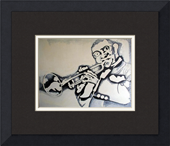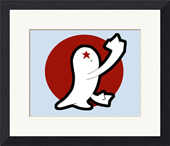EDITOR’S NOTE: Prices and information below may be out of date. Since launching Foliotwist (our own service that creates websites for artists) we no longer feel unbiased enough to continue updating or reviewing other art website services. Visit the website below for their most recent information.
Today I‘m reviewing Imagekind, an online community for artists who want to sell their work via the internet. Quick thanks to William at deCloned for first bringing Imagekind to my attention, as an alternative to eBay.
Imagekind is still fairly new, so you may not have heard of it yet. Basically, it’s a website where artists like you and me can upload digital files of our artwork for others to buy. Individual artists don’t have to deal with the printing, storing, mailing, online credit card transactions. . . None of that.
Instead, Imagekind handles all of it and pays you every time one of your prints sells. The amount you earn simply depends on how much YOU marked up the base price. Best of all, it’s free to become a Member, and it only costs money if you want or need more online storage space for your digital files.
So – easy and free. Sounds great. But the first question that popped into my head was, “Yeah, but does it work? Do people’s art actually sell?”
OK, so I’m a cynic (well, that day I was anyway) but that didn’t keep me from finding out enough about Imagekind to come up with a good unbiased review. As a bonus, you’ll find that each image in the article links back to the artist at Imagekind who created it, so you can get an idea of the art represented there.

Intrigued by this combination of both living members and “old masters,” I did a quick search for “Van Gogh” at Imagekind and was pleased to find Member art popping up as well as some of Van Gogh’s work. This indicated to me that, at least with the search bar, there was no bias towards the Museum Art over Member art.
In that specific case, a Member had tagged her work, “van gogh,” because it was stylistically similar.
Imagekind uses “tags” as a way of classifying art, and, as seen in that example, each Member decides what’s most important about their works of art, and describes them accordingly. Actually, tagging has become the internet’s most popular new method of categorizing items, and so I wasn’t surprised to find that Imagekind is making good use of it.
I also found that Imagekind has a really big selection of frames and matting material, with an easy, visual interface for choosing the perfect combination. This is nice for buyers, and also nice for Members. Why? Well, when a customer buys one of your prints and frames it at the same time, you get a 15% commission from the price of the frame itself.
So for the purposes of this review, I joined up. OK, I admit I was intrigued as well. It sounded good, it looked nice (very well designed site) and I could see how with a little bit of effort right now, POSSIBLY, I could make some money down the road.

If you’re interested, the Pro and Platinum accounts give Members more space on Imagekind’s servers for their artwork, plus that commission I mentioned on frames, AND they also get featured occasionally on Imagekind’s homepage.
Once I felt like I had a handle on how Imagekind worked, I couldn’t help but to see some potential problems. So, despite the fact that I thought it worthwhile enough to join myself, I felt it was important to mention them here.
First, I‘m very curious to know how many Member Prints sell as compared to Museum Prints. The reason why I’m interested is because if Imagekind’s goal is truly to help artists, then I would hope that the Members’ art would outsell the Museum Prints.
The cynical side of me keeps insisting that Imagekind is just using the Web 2.0 marketing strategy of social networking to grow their site, get more traffic, and turn their members into repeat customers.
The other side of me (that’s the artistic, eternally optimistic side) hopes that’s not the case. And, since I don’t know the statistics and it is an extremely new company; I suppose it shouldn’t be an immediate concern.
Second, and more importantly, I’m concerned about the quality of the prints they produce. On their site they suggest uploading art with a DPI between 100 and 300. Then, their computers decide which printing sizes will work with the resolution of the artwork.

Even newspapers print at around 150dpi. Fashion magazines on the other hand are at least 300dpi. The difference in quality is very clear, and I personally wouldn’t want my beloved art prints looking like a newspaper press churned them out.
Now, I know that the specific paper used for newspapers has a lot to do with the poor printing quality. And I’m by no means a printing expert. I’d love to hear how Imagekind’s printing procedure is set up, and I hope that I’m wrong in my estimation of how good the prints actually are.
My third and final issue has to do with server storage. Artists who correctly upload images at 300dpi and a large document size will naturally bypass the printing issue. Their new problem is that the free account will only hold one, or maybe two, large files.
According to Artist Hideout’s post on Imagekind, you need three images to open your gallery to the public. I didn’t try this out myself, but I’ll take his word for it. This means that to make full-size, good, quality prints, you’ll need to pay a monthly fee for more server space. This, of course, kind of tarnishes the whole “free” aspect of Imagekind if it truly is the case.
Looking at both the good and the bad, here’s my overall opinion. Imagekind is on the right track. It’s certainly a new and innovative service for artists, and I think it could be very profitable for some.

Does it really need three sources of income? I can see how for a new company, membership fees probably help a lot, but once Imagekind is on its feet I’d love to those fees disappear.
While that might seem like a naïve hope, I’d imagine that Imagekind would be the type of company to seriously consider it. And if those of us who are Members speak up and actively take roles in their community, our voices WILL carry weight.
You see, although it’s never mentioned, Imagekind gets a HUGE boost from every one of us who join. We invest our time, energy, and art into the company, creating dynamic content, streams of traffic and a ton of links, all of which help Imagekind in its search rankings with Google, probably more than we could ever realize.
When you think about it, Imagekind is our company. We are Imagekind. I guess I hope that the owners will realize that fact, and let the community grow accordingly. If they do, I believe the sky’s the limit in what all of us together could achieve.
Leave me a message at my contact page if you want to chime in on the subject. I’d like to hear about good OR bad experiences you’ve had with Imagekind, and I’ll set apart next Thursday to continue this article with an update. It’ll be a good opportunity for you to make your voice heard, so let me know what you think.
This post may contain affiliate links.

